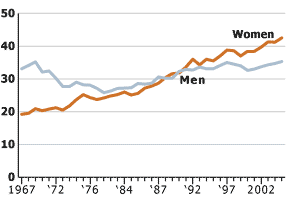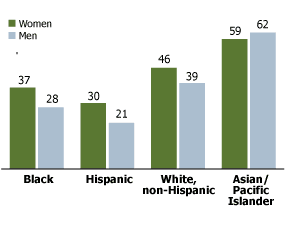Mark Mather
Associate Vice President, U.S. Programs

This is part of a series of PRB articles about the science and engineering (S&E) workforce in the United States, funded by the Alfred P. Sloan Foundation. Additional state-level data on the S&E labor force will be available this spring, in PRB’s 2007 U.S. Population Data Sheet. Data for this article are based on the Population Reference Bureau’s analysis of the U.S. Census Bureau’s Current Population Survey and 2005 American Community Survey.
(February 2007) Since 1991, the proportion of young women enrolled in college has exceeded the enrollment rate for young men, and the gap has widened over time.1 In 2005, about 43 percent of women ages 18 to 24 were enrolled in college, compared with 35 percent of young men. This represents a major shift in the gender balance at U.S. colleges and universities. Between 1970 and 2005, the gender composition has shifted to the extent that women now make up the majority—54 percent—of the 10.8 million young adults enrolled in college.
Figure 1
Proportion of 18-to-24-Year-Old Men and Women Enrolled in College, 1967-2005

Source: U.S. Census Bureau.
Several reasons have been cited for this crossover, including gender differences in academic achievement (girls do better in high school than boys), changes in societal values, and a shift in women’s expectations for future employment.2
Some researchers have focused on these trends as a positive development for young women, who still lag behind men in labor force participation rates and earnings.3 Others view these trends as evidence of the growing social, behavioral, and economic problems facing young men, particularly those in lower-income groups.4 Some colleges are now actively recruiting male students in order to bring men’s enrollment rates in line with those of women.5
Regardless of whether these trends are good or bad, they need to be viewed in a broader context. In particular, what happens to these highly educated women once they leave college? And how do these gender differences relate to broader race/ethnic and state/regional differences in enrollment? Policymakers and campus officials need to pay attention to these issues before they create new gender-based recruitment policies and programs.
Colleges need to balance women’s advantage in enrollment rates against their disadvantage in the post-college labor force. Women’s earnings, relative to those of men, have not kept up with their gains in educational attainment. In 2005, the median weekly earnings for women working full-time were $585, compared with $722 for men.6 Part of this difference reflects the higher concentration of men in higher-paying fields, including the natural and physical sciences, mathematics, and engineering. At the college level, fewer women than men take courses in science-related fields.
The U.S. economy can benefit greatly from women’s educational gains, but only if women are working in occupations that can use their specialized knowledge and skills.
Another often-overlooked issue is the racial/ethnic variation in college enrollment rates. Although the gender gap in enrollment has increased in recent years, it is still much smaller than differences across racial and ethnic groups. In 2005, enrollment rates ranged from 25 percent among Hispanics to 61 percent among Asian Americans. African Americans also had below-average rates of college enrollment—10 percentage points below those of non-Hispanic whites.
Figure 2
U.S. College Enrollment Rates by Race and Ethnicity, 2005

Note: Data reflect persons ages 18-24 enrolled in college, graduate, or professional school.
Source: U.S. Census Bureau.
Gender differences in enrollment are more pronounced for racial and ethnic minorities, especially for blacks and Hispanics. Nationwide, there is a 7 percentage-point gap between men and women’s college enrollment rates. For blacks and Latinos, the gender gap is 9 percentage points.
Recent increases in minority enrollments at U.S. colleges may contribute to the growing gap between male and female enrollment rates. Between 1993 and 2003, minority enrollments increased by 51 percent, while the number of white students increased by only 3 percent.7
For Asians, the gender gap is reversed. Asian men have higher enrollment rates than their female counterparts (although women have gained ground in recent years). The higher concentration of Asians in many large cities on the West Coast contributes to smaller gender gaps in school enrollment in those areas. For example, the San Jose metropolitan area, which has one of the largest concentrations of Asian Americans in the country, has about equal numbers of male and female college students. Among large metropolitan areas, only Salt Lake City has a lower female-to-male student ratio.
Asians and Latinos represent the fastest-growing minority groups in the country. That they have such divergent rates of school enrollment points to the growing social and economic divide among U.S. minorities—particularly for men in these groups.
The gap between male and female enrollment rates also varies in different parts of the country. Southern states have the largest gender gap in enrollment, with an average enrollment ratio of 1.4. (A ratio of 1.4 indicates that there are 140 females enrolled in college for every 100 males.) This may reflect the large concentration of African Americans in these states and the presence of several historically black colleges and universities, which tend to attract and retain more women than men. In Arkansas, for example, there are 250 African American women enrolled in college for every 100 black men. The enrollment ratio for Hispanics and non-Hispanic whites in Arkansas is much lower, at 1.4 each.
Enrollment ratios are smallest in Colorado, Nevada, and Utah. Utah has the lowest ratio of any state, at 0.9, indicating that there are fewer women enrolled than men.
The wide variations in enrollment levels across states and racial/ethnic groups suggest that educational policies need to be implemented at the state or college level in order to meet the needs of all students.
Note: State-level enrollment data are from the 2005 American Community Survey, which did not collect information for people living in group quarters, including college dormitories.
